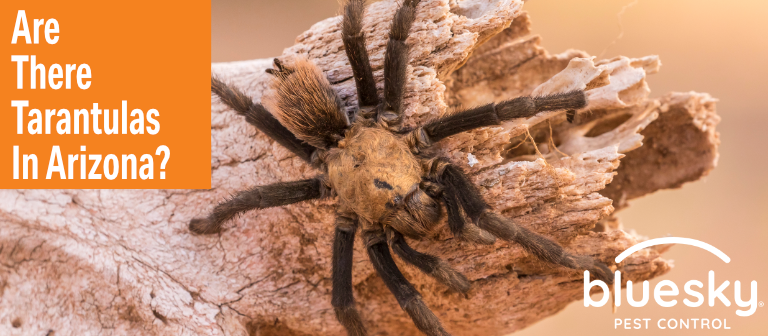$50 OFF New Residential Customers. Learn more
Are There Tarantulas in Arizona?

Tarantulas across the globe thrive in hot climates from deserts to tropical jungles. We often get asked if tarantulas can be found in Arizona? Absolutely! In fact, there are 30 different species of tarantulas that make their home in Arizona. And they happen to be the largest spiders in the state.
If you live in Arizona, chances are you have had a tarantula encounter. Unfortunately, tarantulas have had a bad reputation over the years. Despite the scary depiction in Hollywood films, you don’t have to be intimidated by these large spiders. In reality, they are relatively harmless and shouldn’t be a major concern. However, no one wants to share their home and personal space with large spiders.
In this article, we’re going to cover fascinating facts about these amazing creatures and how to keep tarantulas from finding their way into your Arizona home. If you live in the Phoenix area, including Gilbert, Surprise, and Mesa, and need spider control, we’ll give you a free quote!
What Do Tarantulas in Arizona Look Like?
Adult tarantulas can range in size from half an inch up to 5 inches. The largest tarantulas can weigh up to 1.1 ounces. Depending on the species, their color and markings may vary. Generally, they are light to dark brown in color, with males tending to be darker. Their legs and abdomens are densely covered in hair.
Most Common Types of Tarantulas in Arizona
Tarantulas are generally found living in well-drained and dry soil. Their preferred habitat is areas of either grassland or desert. These arachnids are excellent at hiding under old logs or inside a burrow. Tarantulas feed on grasshoppers, cockroaches, crickets, other insects, and even small mice! Tarantulas are prey to a variety of predators. Some of these may include snakes, frogs, birds, lizards, toads, and javelina.
If you spot a tarantula, it’s helpful to know what type you are dealing with. Fortunately, many have unique physical characteristics to tell them apart.
- Western Desert Tarantula (Aphonopelma Chalcodes) – This spider, also known as the Arizona Blond or Mexican Blond tarantula, is seldom seen. It has light-colored hairs that give it a blond appearance. Its color and docile nature make it a popular pet. In the wild, they live in trees and underground burrows. In addition to its unique coloring, the Western Desert Tarantula is the largest of the Arizona species with a body measuring 3 to 4 inches and a leg span of about 6 inches.
- Grand Canyon Black Tarantula (Aphonopelma Marxi) – This spider is commonly found in Arizona, Utah, Colorado, and New Mexico. They are black or dark brown in color and are very hairy. They often have distinctive red or orange hairs on their bellies. The female of this species is much larger than the male. Females can reach up to 1.4 inches in body length while the males are under an inch. The Grand Canyon Black Tarantula can be found in a wide range of environments from forests to sagebrush plains.
- Carlsbad Green Tarantula (Aphonopelma Gabeli) – This tarantula is different from the ones mentioned above because of its color. The Carlsbad Green has a gray body and is covered with hair. These large spiders are quite reserved but can appear intimidating. They are known for moving into or taking over the burrows left by other animals in areas with well-drained soil.
- Tucson Bronze Tarantula (Aphonopelma Vorhiesi) – These tarantulas are black to brown in color and can be identified by the short, black, bristly hairs that cover their legs. These spiders are larger in size but are very timid. They prefer to remain hidden unless they are being threatened.
Are Arizona Tarantulas Venomous?
Tarantulas do have venom and fangs, but they don’t bite unless they are seriously provoked. When harassed, tarantulas have two main defensive strategies. First, they will try to intimidate their opponent by elevating their cephalothorax and exposing their fangs. If this doesn’t work, they will attempt to bite.
In addition, tarantulas have specialized hairs (called urticating hairs) on the top of their abdomen that contain venom. When under attack, the spider will elevate its abdomen while using its hind legs to brush these hairs into a small cloud. This cloud of hair can cause severe irritation to the mucous membranes of humans or other mammals, especially the eyes and nasal passages. While this can cause inflammation, a rash, or itching, these reactions are not typically dangerous to people. Caution is advised, nonetheless.
It’s a common misconception that tarantulas are aggressive, but it’s just the opposite. In most situations, tarantulas will only attack or bite when they feel threatened. Generally, they give plenty of warning and will bite only if there is no way to escape or avoid conflict. The bottom line is that other smaller pests in Arizona are known to be far more dangerous than tarantulas.
Does a Tarantula Bite Hurt?
Surprisingly enough, tarantula bites aren’t known to be particularly painful. If you do get bitten, the area around the bite may become warm and red with pain similar to that of a bee sting.
The good news is that the venom of a tarantula is relatively weak. It’s very unusual for any serious complications to arise from a tarantula bite, however, an infection could occur and require medical attention if not cared for properly.
Can Arizona Tarantulas Kill You?
There is no doubt that spiders are creepy to most people. That doesn’t mean they are all dangerous or deadly. Don’t let the size of a tarantula fool you. There have been no recorded deaths or severe harm inflicted on humans in Arizona from tarantula bites. This unfortunate myth needs to be laid to rest. While their bites can leave an impressive mark, lasting injuries are practically unheard of.
How to Keep Tarantulas Out of Your Phoenix Home
Tarantulas in the Southwest United States spend most of their lives in burrows or under objects on the ground. They establish these burrows when they are young as their permanent dwellings. As they grow, they enlarge their burrows and hunt only within close proximity to them. Since tarantulas are nocturnal, you will rarely see them during the day.
Since these arachnids live in burrows, they aren’t typically home invaders. Female tarantulas rarely venture away from their nests which means you won’t usually find one in your living room. However, tarantulas can find their way into your home, more than likely in search of food or a mate. Males tend to wander during mating season. The nice thing is that they don’t reproduce quickly so you won’t have to worry about an infestation happening. Here are some simple ways to keep tarantulas out of your home:
- Seal Up Entrances – Even though tarantulas are large spiders, they can still maneuver their way through small cracks and openings. Be sure to seal up any cracks in your foundation, plumbing, siding, windows, and other entrances.
- Declutter Your Home – Tarantulas love to stay hidden. Places such as old furniture, piles of clothing, and stacks of old magazines create the perfect places for a tarantula to hide. Decluttering your home can help deter tarantulas from sticking around.
- Clean Regularly – A clean home is less likely to attract insects that tarantulas like to eat. By keeping your house clean and tidy, you not only eliminate places to hide but also their potential food source.
Keeping Arizona Properties Pest-Free
If you live in the Greater Phoenix metro area, you probably won’t run into many tarantulas, but you will absolutely have to deal with other pests. Call Blue Sky and let our highly trained technicians apply our scientific approach to pest control. Keep your home or business worry-free because it is pest free.
Related Posts

Red & Black Intruders: Meet Arizona’s Boxelder Bugs
Boxelder Bugs in Arizona If you’ve ever stepped outside and spotted a cluster of black-and-red bugs crawling on your porch…

Jumping Spiders in Arizona: Harmless or Hazardous?
Jumping spiders in Arizona might be small, but they can sure give you a big surprise when they suddenly appear…

The Guide to Carpet Beetles in Arizona
Carpet beetles in Arizona might be tiny, but they can certainly do some damage. Known for their vibrant, patterned exoskeletons,…